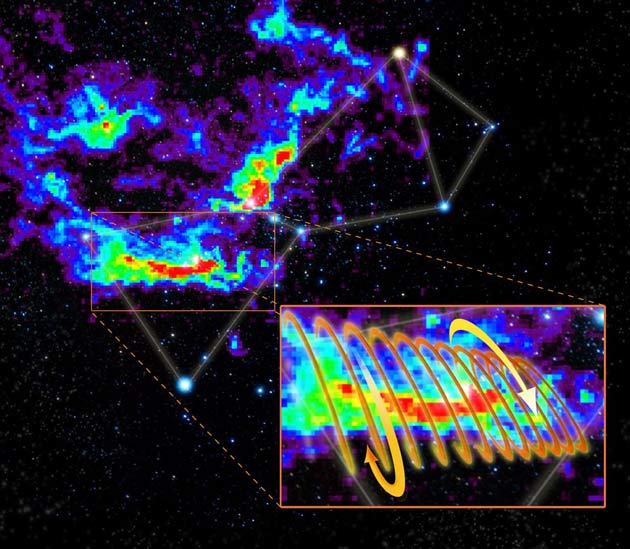
WASHINGTON, D.C.-Astronomers have discovered a giant magnetic field that is coiled like a snake around a rod-shaped gas cloud in the constellation Orion.
Timothy Robishaw, a graduate student at the University of California, Berkeley, involved in the discovery, described the structure as a "giant, magnetic Slinky wrapped around a long, finger-like interstellar cloud."
Astronomers call that wound-up shape "helical."
The discovery, presented here this week at a meeting of the American Astronomical Society, was made in the Orion Molecular Cloud, a known stellar nursery in the constellation Orion. It supports a previous theory about how magnetic fields interact with interstellar gas clouds.
In 2000, Jason Fiege and Ralph Pudritz from McMaster University suggested that filamentary clouds like the Orion Molecular Cloud might exhibit a helical magnetic field around their long axis. This discovery is the first confirmation of their theory.
Astronomers have long suspected that magnetic fields, combined with gravity, help to pull dust inside the clouds together to make stars. But magnetic fields in space are difficult to detect.
"The [magnetic] field in interstellar space is very weak and there are systematic measurement effects that can produce erroneous results," Robishaw said.
Breaking space news, the latest updates on rocket launches, skywatching events and more!
The helical shape of the magnetic field is believed to be caused by matter in the interstellar cloud moving in a straight line along the length of the filament. When this happens, it causes the magnetic field around the cloud to spiral around in a corkscrew pattern. The researchers were able to detect this spiral shape using the Green Bank Telescope, a radio observatory in West Virginia.
Carl Heiles, an astronomer at UC Berkeley who headed the study, said that there is one other possible explanation for the magnetic field's helical shape. It may be that streaming jets of high-energy particles from the neighboring constellation Eriandus produced magnetic waves that were transported by shockwaves to the Orion Molecular Cloud, Heiles said.
Once there, the magnetic field could have wrapped around the cloud in the spiral pattern that was observed.
The researchers said that further study is needed to distinguish between the two possibilities.
- Space Tornado! Cosmic Front Packs a Punch
- Amazing Images: Your Space Pictures
- The Best of the Hubble Space Telescope
Join our Space Forums to keep talking space on the latest missions, night sky and more! And if you have a news tip, correction or comment, let us know at: community@space.com.
Ker Than is a science writer and children's book author who joined Space.com as a Staff Writer from 2005 to 2007. Ker covered astronomy and human spaceflight while at Space.com, including space shuttle launches, and has authored three science books for kids about earthquakes, stars and black holes. Ker's work has also appeared in National Geographic, Nature News, New Scientist and Sky & Telescope, among others. He earned a bachelor's degree in biology from UC Irvine and a master's degree in science journalism from New York University. Ker is currently the Director of Science Communications at Stanford University.
